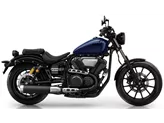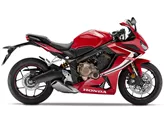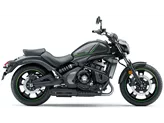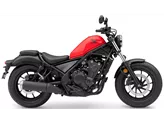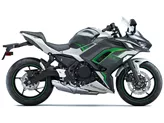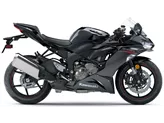Kawasaki Ninja 650 2017 vs. Kawasaki Vulcan S 2015

Kawasaki Ninja 650 2017

Kawasaki Vulcan S 2015
Overview - Kawasaki Ninja 650 2017 vs Kawasaki Vulcan S 2015
The Kawasaki Ninja 650 model year 2017 and the Kawasaki Vulcan S model year 2015 are both motorcycles produced by Kawasaki, but they have some notable differences.
In terms of engine and drive train, both models have an in-line engine with the same bore and stroke measurements. However, the Ninja 650 has a slightly higher engine power of 68.2 HP compared to the Vulcan S's 61 HP. The Ninja 650 also has a higher torque of 65.7 Nm compared to the Vulcan S's 63 Nm. Both models have a compression ratio of 10.8 and use a chain transmission. They also have the same number of cylinders and use liquid cooling. The displacement of both models is 649 ccm.
In terms of chassis, both models have a steel frame. However, the Ninja 650 has a tubular frame type, while the Vulcan S has a perimeter frame type.
When it comes to brakes, the Ninja 650 has double disk brakes at the front, while the Vulcan S has a single disk brake at the front. Both models have the same front and rear tire widths of 120 mm and 160 mm, respectively. However, the Vulcan S has a slightly larger front tire diameter of 18 inches compared to the Ninja 650's 17 inches. Both models have a rear tire diameter of 17 inches.

Kawasaki Ninja 650 2017
In terms of dimensions and weights, the Ninja 650 has a shorter wheelbase of 1410 mm compared to the Vulcan S's 1575 mm. The Ninja 650 also has a higher seat height of 790 mm compared to the Vulcan S's 705 mm. The Ninja 650 has a lower kerb weight (with ABS) of 193 kg compared to the Vulcan S's 228 kg. Both models have a fuel tank capacity of 14 liters.
Now, let's discuss the strengths and weaknesses of each model.
The Kawasaki Ninja 650 2017 has several strengths. It has a transparent chassis that gives it a sporty look. It also has playful and good-natured handling, making it enjoyable to ride. The Ninja 650 has excellent brakes, providing reliable stopping power. Its sharp looks are reminiscent of the ZX-10R, giving it a sporty and aggressive appearance. The engine of the Ninja 650 is resilient and delivers strong performance.

Kawasaki Vulcan S 2015
However, the Ninja 650 also has some weaknesses. It produces little sound from the stock exhaust, which may disappoint riders looking for a more aggressive sound. The engine also exhibits slight vibrations, which may be noticeable during long rides.
On the other hand, the Kawasaki Vulcan S 2015 has its own set of strengths. It has a rev-happy engine that performs well in both high and low rev ranges. The Vulcan S also has decent brakes with ABS, ensuring safe and controlled braking. Its idiosyncratic look sets it apart from other motorcycles. The narrow 160 rear tire makes the Vulcan S maneuverable, enhancing its agility. The Ergo-Fit system allows riders to customize the bike for optimum comfort and fit.
However, the Vulcan S also has some weaknesses. The Ergo-Fit system is an optional extra, which means it comes at an additional cost. The wind protection on the Vulcan S is moderate, which may result in increased wind resistance at higher speeds. Additionally, the gear indicator is only available as an option, which may be inconvenient for riders who prefer to have this feature as standard.
In conclusion, the Kawasaki Ninja 650 2017 and the Kawasaki Vulcan S 2015 have their own unique strengths and weaknesses. The Ninja 650 offers sporty looks, excellent brakes, and a resilient engine. The Vulcan S, on the other hand, has a rev-happy engine, decent brakes with ABS, and a customizable Ergo-Fit system. Riders should consider their preferences and priorities when choosing between these two models.
Technical Specifications Kawasaki Ninja 650 2017 compared to Kawasaki Vulcan S 2015
Pros and Cons in comparison
Pros and Cons in comparison
Kawasaki Ninja 650 2017

The Ninja 650 firmly stamps its predecessor (Er-6f). The engine has mastered the Euro 4 hurdle well and serves up a very usable 68 hp, the chassis is simply great for this class, and the weight reduction of 18(!) kilos compared to the ER-6f justifies reverent nods.
Kawasaki Vulcan S 2015

The Vulcan S is reinvigorating the "small" mid-size cruiser scene - not only because of its unique design, but also because it is so easy to ride and is aimed at beginners. The low seat height and the narrow saddle help the rider to stand securely on the ground, while the low centre of gravity also makes for easy and safe handling. The engine also fits in well with the uncomplicated appearance, can be revved up decently from 2000 rpm and only stops at around 10,000 rpm - something that has never been seen before in a cruiser. The "Ergo-Fit" system, which varies the seat height, the rider's distance from the handlebars and the footrests, costs extra but also allows the Vulcan S owner generous customisation options.
Price Comparison Avarage Market Price Kawasaki Ninja 650 vs Kawasaki Vulcan S
There are a few key differences between a Kawasaki Ninja 650 2017 and a Kawasaki Vulcan S 2015. In terms of price, the actual average prices of both motorbikes are almost the same. A Kawasaki Ninja 650 2017 experiences a loss of 380 USD in one year and 500 USD in two years of ownership. This is offset by a loss of 380 USD and 400 USD for a Kawasaki Vulcan S 2015. Compared to Kawasaki Vulcan S 2015 there are less Kawasaki Ninja 650 2017 bikes available on the 1000PS.de Marketplace, specifically 7 compared to 8. It takes less time to sell a Kawasaki Vulcan S with 75 days compared to 96 days for the Kawasaki Ninja 650. Since model year 2017 1000PS.de editors have written 20 reviews for the Kawasaki Ninja 650 and 13 reviews for the Kawasaki Vulcan S since model year 2015. The first review for the Kawasaki Ninja 650 was published on 10/4/2016 and now has more than 79,600 views. This compares to more than 14,800 views for the first review on Kawasaki Vulcan S published on 10/16/2014.











